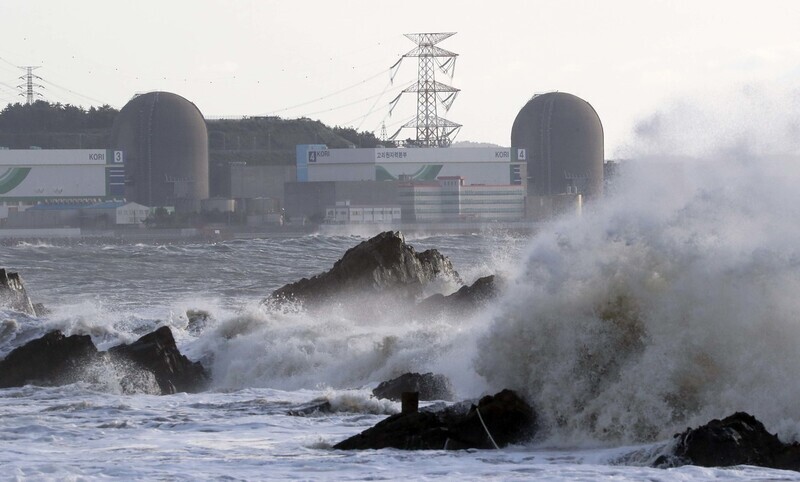hankyoreh
Links to other country sites 다른 나라 사이트 링크
Six reactors shut down due to salinity during recent typhoons

The recent shutdown of six nuclear reactors at South Korea’s Kori and Wolsong nuclear power plants during the typhoons Maysak and Haishen resulted from the failure of power supply equipment, which was caused by salinity carried on the gale, according to an independent investigation by South Korea’s nuclear operator. This was an issue that should have been foreseen and forestalled at a coastal nuclear plant, which is likely to raise concerns about the safety of nuclear power.
Four nuclear reactors (Shin Kori-1, Shin Kori-2, Kori-3, and Kori-4) automatically shut down at night on Sept. 3 and early in the morning on Sept. 4 while Typhoon Maysak was overhead. Then on the morning of Sept. 7, two more nuclear reactors (Wolsong-2 and Wolsong-3) were brought to a halt because of Typhoon Haishen.
On Sept. 9, Korea Hydro and Nuclear Power (KHNP) provided the following explanation of the cause of the shutdown at these reactors. “The powerful winds and waves whipped up by the typhoon caused a large amount of salinity to enter the power supply equipment at the power plant. That in turn caused breakdowns, triggering breakers that are in place to protect the generating equipment.”
The KHNP’s explanation can be regarded as recognition that the design and operation of nuclear power plants are vulnerable to the extreme weather events that are brought by climate change. Considering that all of Korea’s nuclear plants are located near the coast, precautions should have been taken against salinity in the plants’ design and operation. A protracted suspension of the external power supply could cause a meltdown of the nuclear fuel rods, which is what happened during the nuclear disaster at Fukushima in Japan.
The KHNP placed the blame on the typhoon, which turned out to be stronger than expected. “The facility was designed with insulation because of its coastal location, but the wind was so strong that foam from the waves reached the hills on the other side of the reactor. The exposed equipment was vulnerable,” a KHNP spokesperson said.
“Equipment outside of nuclear reactors uses waterproof parts as a precaution against rainwater or saltwater. Even if salinity is the cause, as the KHNP claimed, the real problem might be poor-quality parts and slapdash construction,” said Han Byeong-seop, director of the Institute for Nuclear Safety.
Shortly after the nuclear disaster in Fukushima in 2011, the South Korean government ordered the KHNP to implement 46 measures aimed at countering extreme natural disasters. The project was divided into phases that were supposed to be completed by 2015. But three of the measures remain incomplete: namely, installing watertight doors and waterproof pumps, installing exhaust or decompression equipment on the containment vessel, and improving anti-flooding measures in the main steam safety valve room and the emergency pump room.
By Kim Jeong-su, senior staff writer
Please direct comments or questions to [english@hani.co.kr]

Editorial・opinion
![[Column] Season 2 of special prosecutor probe may be coming to Korea soon [Column] Season 2 of special prosecutor probe may be coming to Korea soon](https://flexible.img.hani.co.kr/flexible/normal/500/300/imgdb/original/2024/0426/3317141030699447.jpg) [Column] Season 2 of special prosecutor probe may be coming to Korea soon
[Column] Season 2 of special prosecutor probe may be coming to Korea soon![[Column] Park Geun-hye déjà vu in Yoon Suk-yeol [Column] Park Geun-hye déjà vu in Yoon Suk-yeol](https://flexible.img.hani.co.kr/flexible/normal/500/300/imgdb/original/2024/0424/651713945113788.jpg) [Column] Park Geun-hye déjà vu in Yoon Suk-yeol
[Column] Park Geun-hye déjà vu in Yoon Suk-yeol- [Editorial] New weight of N. Korea’s nuclear threats makes dialogue all the more urgent
- [Guest essay] The real reason Korea’s new right wants to dub Rhee a founding father
- [Column] ‘Choson’: Is it time we start referring to N. Korea in its own terms?
- [Editorial] Japan’s rewriting of history with Korea has gone too far
- [Column] The president’s questionable capacity for dialogue
- [Column] Are chaebol firms just pizza pies for families to divvy up as they please?
- [Column] Has Korea, too, crossed the Rubicon on China?
- [Correspondent’s column] In Japan’s alliance with US, echoes of its past alliances with UK
Most viewed articles
- 1‘We must say no’: Seoul defense chief on Korean, USFK involvement in hypothetical Taiwan crisis
- 2[Column] Season 2 of special prosecutor probe may be coming to Korea soon
- 3N. Korean delegation’s trip to Iran shows how Pyongyang is leveraging ties with Moscow
- 4Korea sees more deaths than births for 52nd consecutive month in February
- 5Amnesty notes ‘erosion’ of freedom of expression in Korea in annual human rights report
- 6[Reportage] On US campuses, student risk arrest as they call for divestment from Israel
- 7[Editorial] New weight of N. Korea’s nuclear threats makes dialogue all the more urgent
- 8‘Weddingflation’ breaks the bank for Korean couples-to-be
- 9[Column] Has Korea, too, crossed the Rubicon on China?
- 10[Column] Park Geun-hye déjà vu in Yoon Suk-yeol